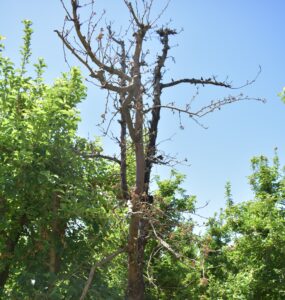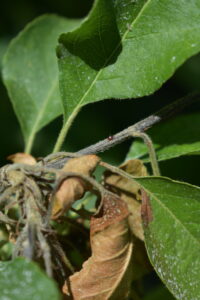Growing Together Winter 2024
Partnership Adds Economical New Control and Resistance Management in Bacterial Disease Fight
Fire blight is a bacterial disease that can quietly infiltrate a pome fruit orchard and inflict massive short- and long-term damage, and there aren’t a lot of ways to prevent or control it.
But with well-informed guidance, the right combination of cultural practices and rotating crop protection products, growers can manage bacterial diseases and help manage resistance that can render any control measure ineffective. It’s just one case in which working with the right experts in the field, specifically Grow West PCAs with intimate knowledge of each orchard and its susceptibility to such diseases, can set up growers for successful, productive and high-quality crops year after year.
Caused by the bacterium Erwinia amylovora, fire blight is one of a group of bacterial diseases that under optimal conditions can infect trees in early spring, especially when the bacteria overwinter in or near orchards. When perennial cankers become active due to warming temperatures in the early season, bacterial reproductive cells can move to tree buds, flowers and later, fruit itself. Given favorable environmental conditions, this process can damage the tree’s economic potential by destroying developing branches and fruit. Once a tree is infected, fire blight’s life cycle is difficult to disrupt and it will likely overwinter again and continue its life cycle until growers or orchard managers can take corrective measures. That normally means removing diseased wood and plant tissue by pruning and burning.
But controlling fire blight and similar bacterial diseases is about more than just keeping your eyes peeled for their signs, treating them and removing diseased tissue. It’s about year-round awareness, action and a key distinction that should guide every grower’s bacterial disease management program. Prevention and control are two different outcomes, especially for any disease that can quickly and easily turn into a major problem in which complete prevention is often not an option.
“Bacterial disease control implies there’s a certain level of inoculum of that organism in a crop, so the job becomes trying to minimize its damage. Prevention is keeping the organisms from the crop so you’re never having to control it. That’s really the goal, but these pathogens are so adaptable that prevention isn’t really possible. So control becomes necessary,” said Grow West Technical Services Manager Layne Wade. “And that takes the right mix of crop protection products and cultural practices in making the right recommendations for growers.”

That’s the exact scenario facing pear, cherry and wine grape grower Jeff McCormack of Walnut Grove. His pear crop was destroyed by fire blight in 2015, and since then, he’s been “keeping his guard up so it doesn’t happen again.”
For McCormack, prevention is a ship that’s already sailed and it’s a matter of controlling fire blight. That effort requires him to make orchard sanitation, cleanliness and attention to crop protection programs year-round priorities. Treatment with the right antibacterial applications and cultural practices like removing infected wood round out his approach to keeping fire blight at bay on the orchard his family’s managed for over 120 years.
“I’ve been keeping my guard up since the last blight epidemic. It took a ton of time and energy to get back where we want to be in terms of production and I sure don’t want to see that happen again,” McCormack said. “Blight management is a matter of staying on top of it.”
That starts well before the growing season begins. Knowing it overwinters and can come on strong if left untreated, McCormack starts his fire blight management program in mid-February with applications of copper to hit any blight spores that have overwintered in his orchards. He follows that up with rotated streptomycin and kasugamycin applications beginning in March.
For McCormack, it’s a solid strategy that responsibly leverages the latest tools and products at his disposal. What makes it work? Copper has long been a component of most effective blight management programs. But with any such crop protection strategy, the overreliance on a single active ingredient or chemistry can lead to resistance in the targeted pests, diseases or weeds. In the case of bacterial disease specifically, that can be especially dangerous given the small number of effective management options. McCormack is constantly aware of resistance management in how he selects what he applies every growing season.
“Resistance management is important. If I’m out there spraying something that’s not working, what’s the point? I’m just wasting a lot of money,” he said.
That’s why a kasugamycin-based bactericide has been such a welcome addition for McCormack since the chemistry adds a new tool to control or manage fire blight. KASUMIN® Bactericide is the only Group 24 bactericide with kasugamycin as its active ingredient and introduces a unique mode of action with no cross-resistance. It’s tank-mixable so it can be easily integrated into a McCormack’s diversified application strategy for controlling fire blight.
KASUMIN’s availability comes at a critical time for California pome fruit and tree nut growers. Newer varieties have raised the bar for overall yield and quality but at the same time, some have shown greater susceptibility to bacterial disease like fire blight. The combination of increased likelihood of infection and resistance as well as limited comparable controls make KASUMIN a welcome addition for effective control of diseases that show increasing signs of resistance to streptomycin and copper.

“KASUMIN came in at a time when resistance to other materials had been building, especially with fire blight in apples and pears and bacterial blast in almonds. There are isolates that are resistant to copper all over the state,” Wade said. “Some of the newer varieties of almonds and pome fruit are more sensitive to bacterial infections than others. As our industry develops more varieties like them, we’re finding new bacterial impacts that we haven’t faced before. KASUMIN has been very effective. It’s been huge for us, especially given that these crop industries have been here 100 years and there are only three or four products registered for bacterial diseases.”
The cost to effectively manage bacterial diseases like fire blight — whether that means prevention or control — is a major factor driving how growers integrate products like KASUMIN into their programs. Just how proactive a grower is with managing such diseases is a big part of the economic discussion.
“A lot of what goes into deciding whether you’re going to spray for bacterial diseases is usually around the environment or economics. If economics means the price of the commodity doesn’t justify it and you can’t afford it, you may not spray. But once you see the damage bacterial diseases cause, you really can’t afford not to do it,” said Katie Driver, walnut grower and technical services manager for UPL, manufacturer of KASUMIN. “Some of the economic decisions that go into the application decision are your orchard’s breakeven price and how much you can afford to spend before you can absorb a loss. Sometimes it just doesn’t pencil to do it.”
The age of an orchard is a big part of that decision-making process, Driver added. “If your orchard is older, you may choose not to spray. If it’s earlier and you want to be overly proactive, you’ll obviously choose to spray. It really comes down to these factors: the age of trees and your breakeven. Those are the two questions you have to ask yourself before you make an application.”
Making a cost-effective, balanced decision like that takes teamwork. That’s the approach Wade takes to the orchard whenever he’s working with a grower, whether it’s to prevent or control fire blight or any similar crop disease.
“Our approach is very collaborative with the growers. We are focused on what we do best and we can only do that by being partners with our growers. We don’t just look at growers as customers per se, but as partners,” Wade said. “I know I personally have such a respect for how difficult crop disease management is, and we try to do everything we can to help them in their operations and make it profitable for them.”
Talk to your Grow West PCA today to start planning your 2024 bacterial disease management program.
